In one look
Expert assessment
Advantages
- Superb power and performance in the palm of your hand
- Game emulation is solid and can be changed for better results
- Large dynamic IPS display
- Fantastic battery life
The inconvenients
- The operating system user interface is still confusing and unpolished
- Slight bleeding around the edge of the screen
- Adjusting the brightness and volume is boring
Our verdict
The new PocketGo does not replace the original PocketGo, it offers more power, a bigger package and the ability to play Playstation games, but at double the price.
BittBoy’s new PocketGo (or PocketGo 2) doesn’t replace the original PocketGo, it’s an older sibling that’s twice the size and more powerful in many ways. With it, BittBoy continues to iterate over the portable retro gaming emulator, evolving hardware and allowing smoother emulation beyond the 16-bit era.
While the price ($ 66 from Retromimi) is double that of the original PocketGo, it’s still great value for money. The new PocketGo is now my go-to recommendation for handheld game emulation.
Tony Hawk’s Pro Skater 2 looks great and plays great on the new PocketGo.
Old PocketGo vs New PocketGo
As I mentioned before, the new PocketGo doesn’t really replace the original / old PocketGo, it just boosts almost every aspect of the experience, including the price. At around $ 40 on Amazon, the OG PocketGo was a no-brainer for retro game enthusiasts like myself who wanted to take their ROMs on the go. But hardware was only able to play reliably until the 16-bit era (including GameBoy Advance).
 Adam Patrick Murray / IDG
Adam Patrick Murray / IDGPocketGo (top) vs. new PocketGo (bottom)
The new PocketGo easily plays games from the PlayStation era and improves 16-bit emulation with optimized internals. The move from a 533 MHz to 1 GHz processor is useful, as is the huge step forward from 32MB of DDR RAM to 512MB of DDR2 RAM.
The battery capacity has also increased from 1000mAh to 2000mAh, and the battery is easily removable from a back panel. The battery life of the original PocketGo was phenomenal. Even with heavier internal components, the new PocketGo can last that long with double the capacity.
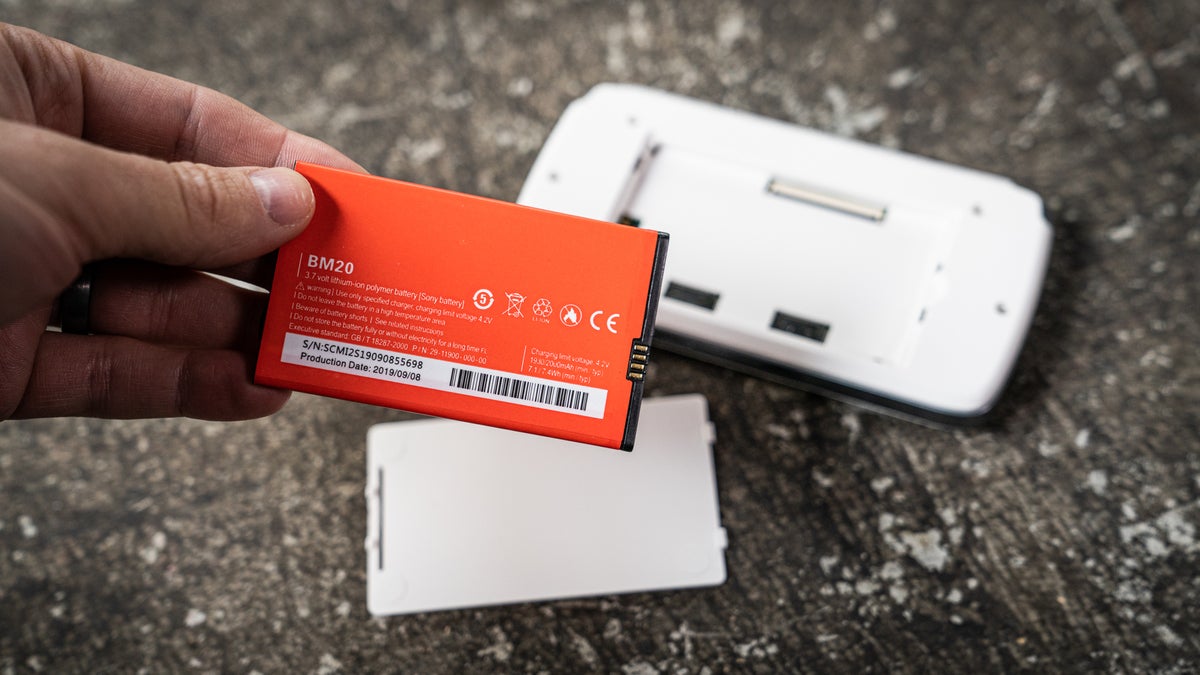 Adam Patrick Murray / IDG
Adam Patrick Murray / IDGRemovable batteries are always appreciated.
The screen size has grown from 2.5 inches on the OG PocketGo to 3.5 inches on the new PocketGo, but it retains the familiar 320 × 240, 3: 2 aspect ratio. The original’s IPS display was already phenomenal, and the new one is just as good, so no complaints. I noticed a slight bleeding around the edges of the screen in low light situations, which can be annoying, but it’s low enough that I couldn’t even take a good picture of it.
The new PocketGo now also includes a second MicroSD card slot for loading ROMs and media files. It comes with a 32 GB MicroSD card already loaded with the Linux based operating system and a handful of ROMs, and placed in the first slot. Although inserting a FAT32 format MicroSD card slot with your ROMs in the second slot is the recommended way to play yours, I was able to easily place ROMs on the original MicroSD card via a new function. FTP included in the software.
 Adam Patrick Murray / IDG
Adam Patrick Murray / IDGDual MicroSD card slots are a nice upgrade
The last major difference between the two handhelds is the addition of a single controller to the left side of the new PocketGo for use in PlayStation games. Unfortunately, it is horrible. This is not a true analog stick, but rather a sliding pad closer to what was found on the PSP and PS Vita. I guess it works in a pinch, but I’ll probably never use it. What I will use is the second pair of shoulder buttons added at the top, bringing the total number to four, and following the original PlayStation controller.
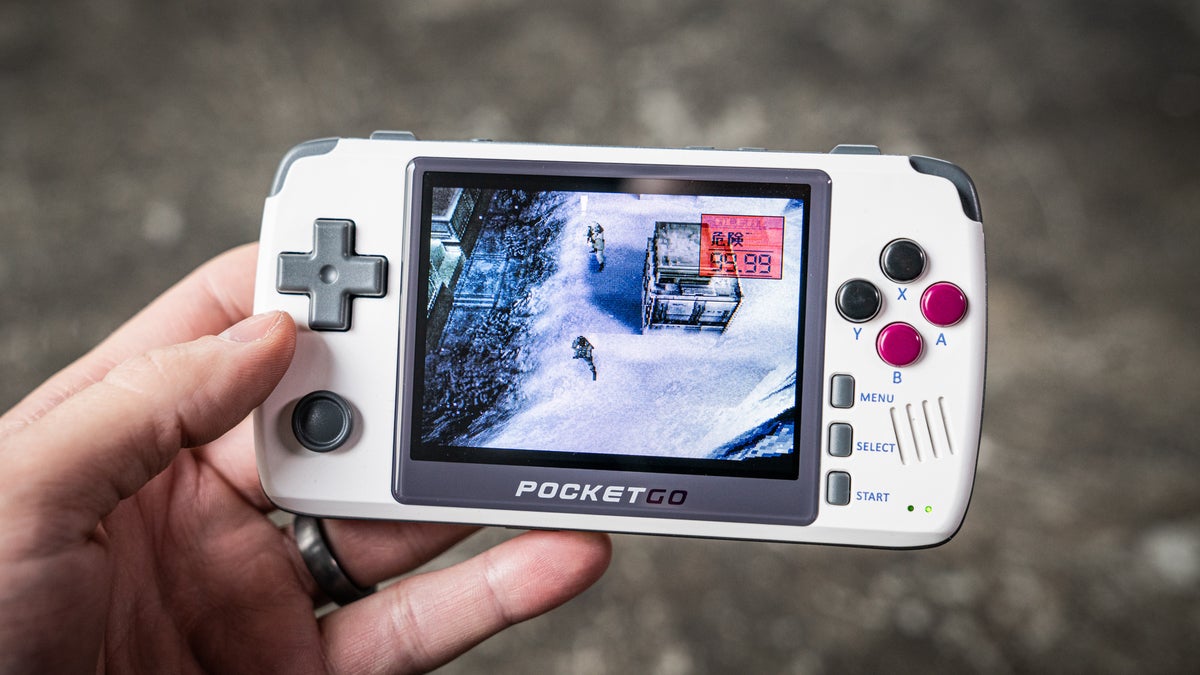 Adam Patrick Murray / IDG
Adam Patrick Murray / IDGThe controller of the new PocketGo is bad.
The Micro-USB port for charging has been replaced with a USB-C connector, which is a welcome upgrade. You just need to make sure to use the included charging cable for the most efficient connection.
The new PocketGo is noticeably bigger and heavier than the original PocketGo, but it’s a better experience in almost every way. The added size helps with hand fatigue and the extra weight makes it more substantial in the hand (although it’s still a plastic shell). While the hardware isn’t perfect at all and won’t win any design awards, functionally everything is there and works pretty well.
Play on the new PocketGo
Like the older devices from BittBoy, you should know that these portable devices are not for gamers trying to find the most accurate emulation experience. Screen tearing, slowdown, and audio issues have popped up here and there, but most of the time the games perform well enough that I can enjoy them even without changing anything in the emulator settings.
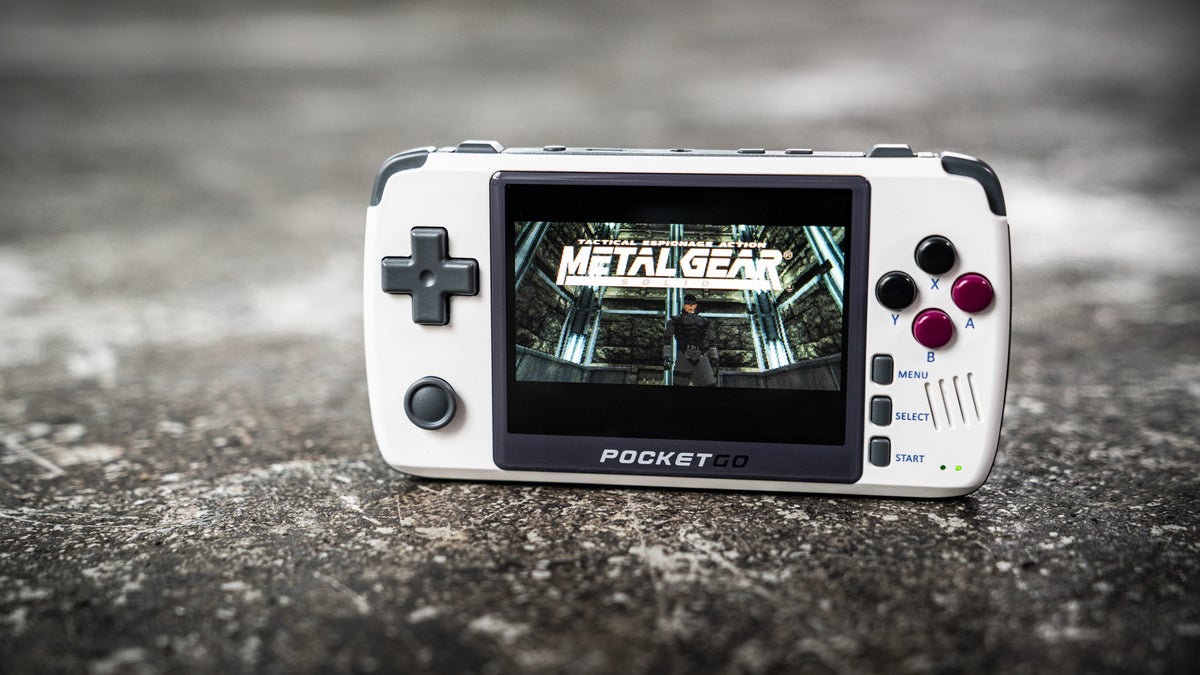 Adam Patrick Murray / IDG
Adam Patrick Murray / IDG“A strong man doesn’t need to read the future. He does his own.
Unfortunately, the way the brightness and volume are adjusted on the new PocketGo has somehow got worse. Gone is the volume dial, replaced by buttons on the top to increase and decrease the volume. It wouldn’t be that bad, but the lowest volume setting is very loud, and I can’t find a way to offer more granular control, so it’s either muted or too loud to play quietly in environments. calmer.
In addition to that, you need to adjust the brightness by holding the Select button and pressing the ‘Volume -‘ button to to augment brightness, and the ‘Volume +’ button to decrease the luminosity. It seems to adjust the brightness by one step out of 100, which means you have to hold the button down for a while to see an effect.
In addition to the back placement and tiny steps, it also adjusts the volume at the same time. Yeah, as I sit there playing Tony hawk in a dark and quiet room and trying to lower the light I start to blast the menu music at the same time. If that sounds confusing and boring, that’s because it is.
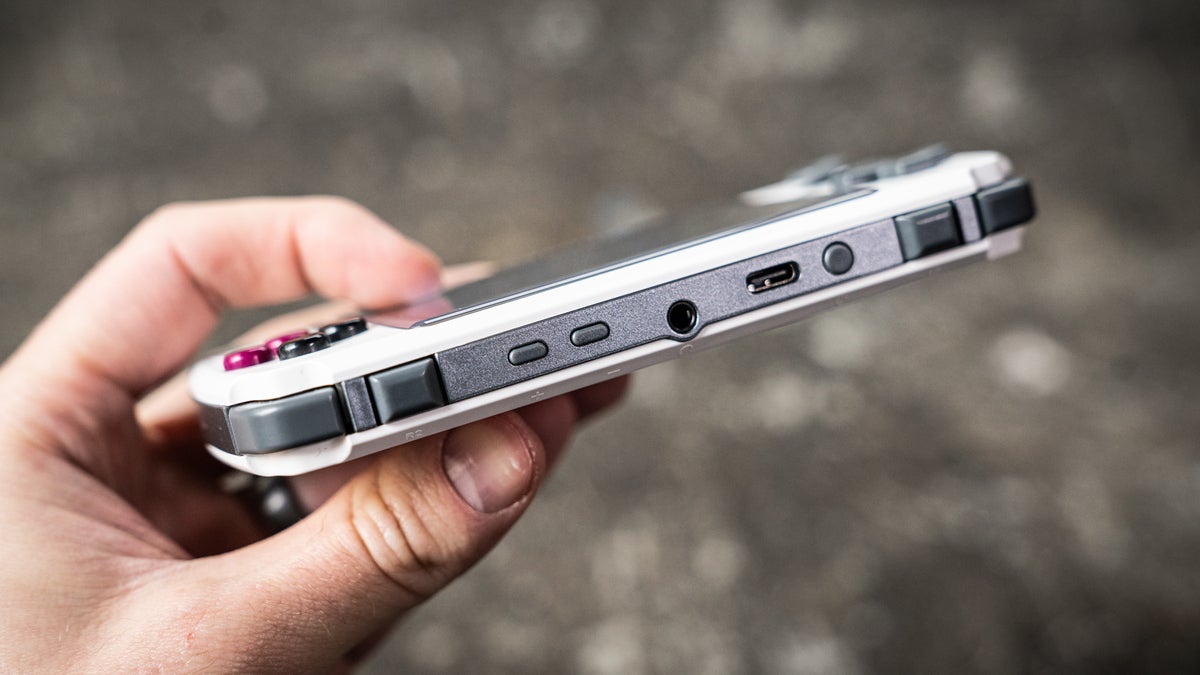 Adam Patrick Murray / IDG
Adam Patrick Murray / IDGSide-by-side shoulder buttons, power button, headphone jack, and volume buttons line the top of the device.
The Linux-based operating system running on the new PocketGo also retains its fair share of quirks like past iterations, but once you get used to how you have to navigate and start playing your games, it’s not isn’t a huge downside. The only thing that needs to be improved ASAP is to have a better overview of battery life. The little indicator doesn’t give me enough information and is generally inaccurate, which is a real disappointment.
Once in the game, all of that worry subsides and I can play games from my past in ways I never thought possible. Have the ability to grind a long RPG on PS1 like Xenogears, or take a quick run on Tony Hawk Pro Skater 2 it just makes me smile and lets me relive some of my favorite gaming memories and share them easier than ever.
Traditionally, PlayStation emulation is not as straightforward as Super Nintendo emulation. Every game I have tried has had unique issues with the emulator’s default settings. The controls always seemed responsive enough, and the new PocketGo’s screen offers plenty of rich color and detail. Despite the emulation hiccups, it was still nice to have the ability to play these classic games in the palm of my hand. My nostalgia probably obscures my ability to be frustrated with the actual technology that makes games work, but for me that’s enough to recommend the PocketGo.
Should you buy the new PocketGo 2?
If you want a small portable retro gaming emulator and want to play the classics from the 8 and 16 bit eras, then the original PocketGo is hard to pass up because it is so simple and affordable. But if you want a bigger device, a bigger screen, faster hardware, and the ability to play games from the PlayStation era, then the new PocketGo is where you want to look, as long as you can tolerate it. annoying volume and brightness settings.
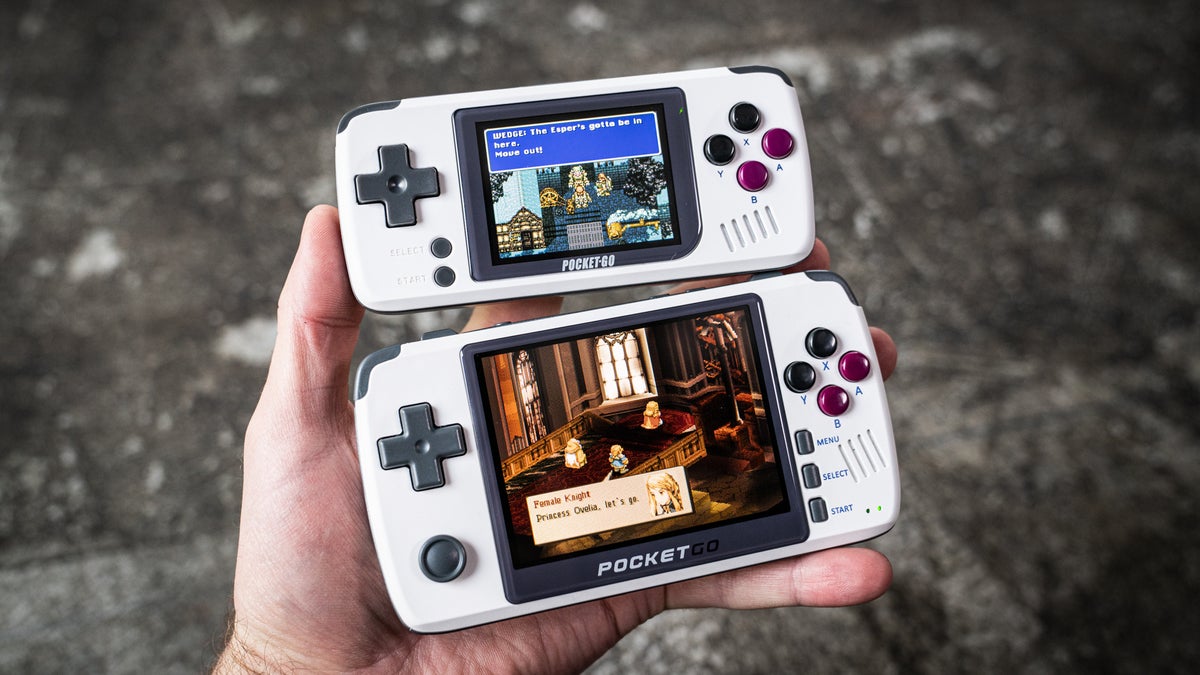 Adam Patrick Murray / IDG
Adam Patrick Murray / IDGBoth versions of the PocketGo offer a reason to own it.

